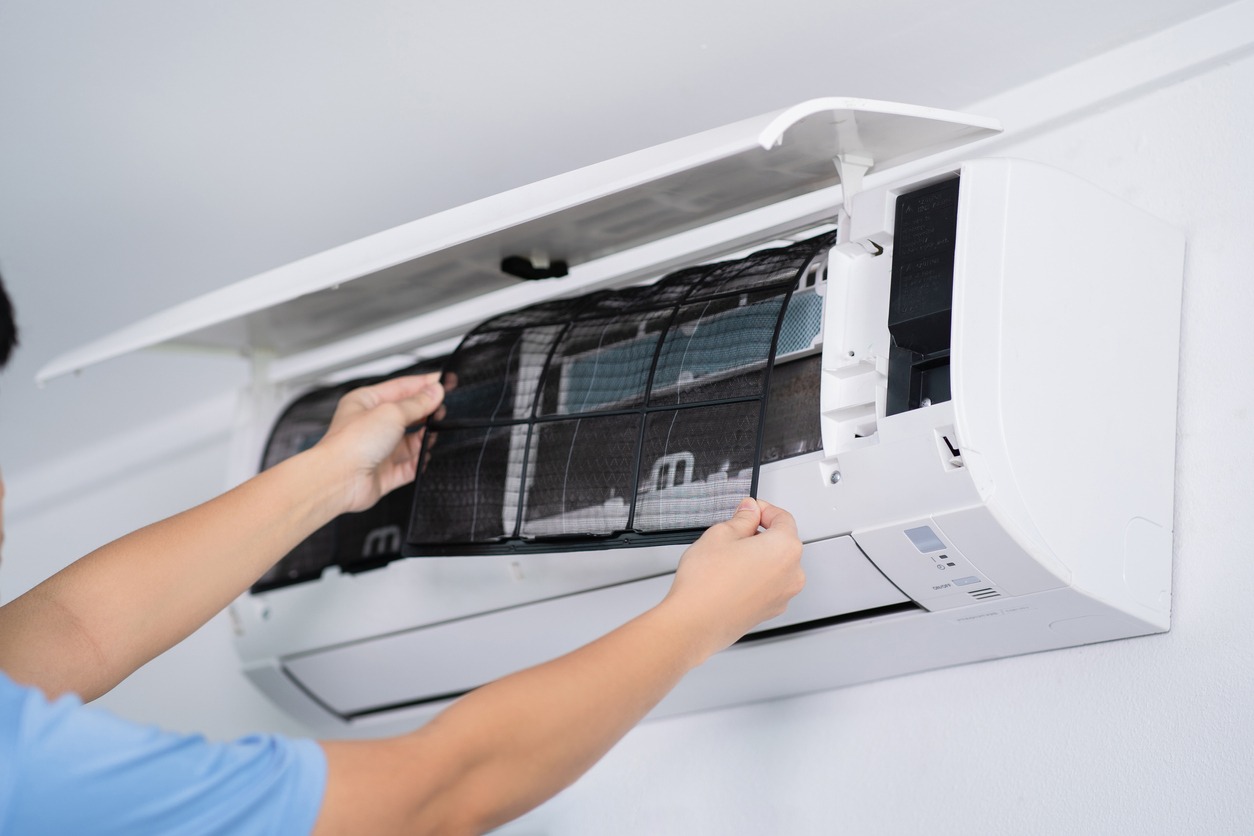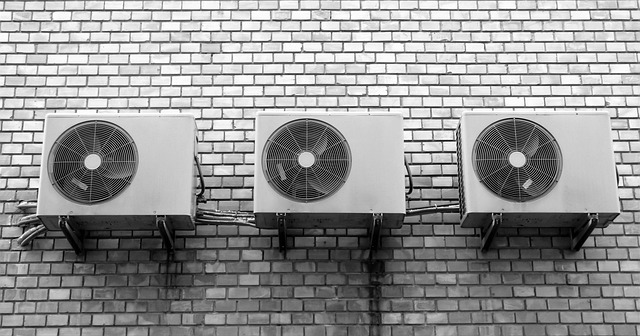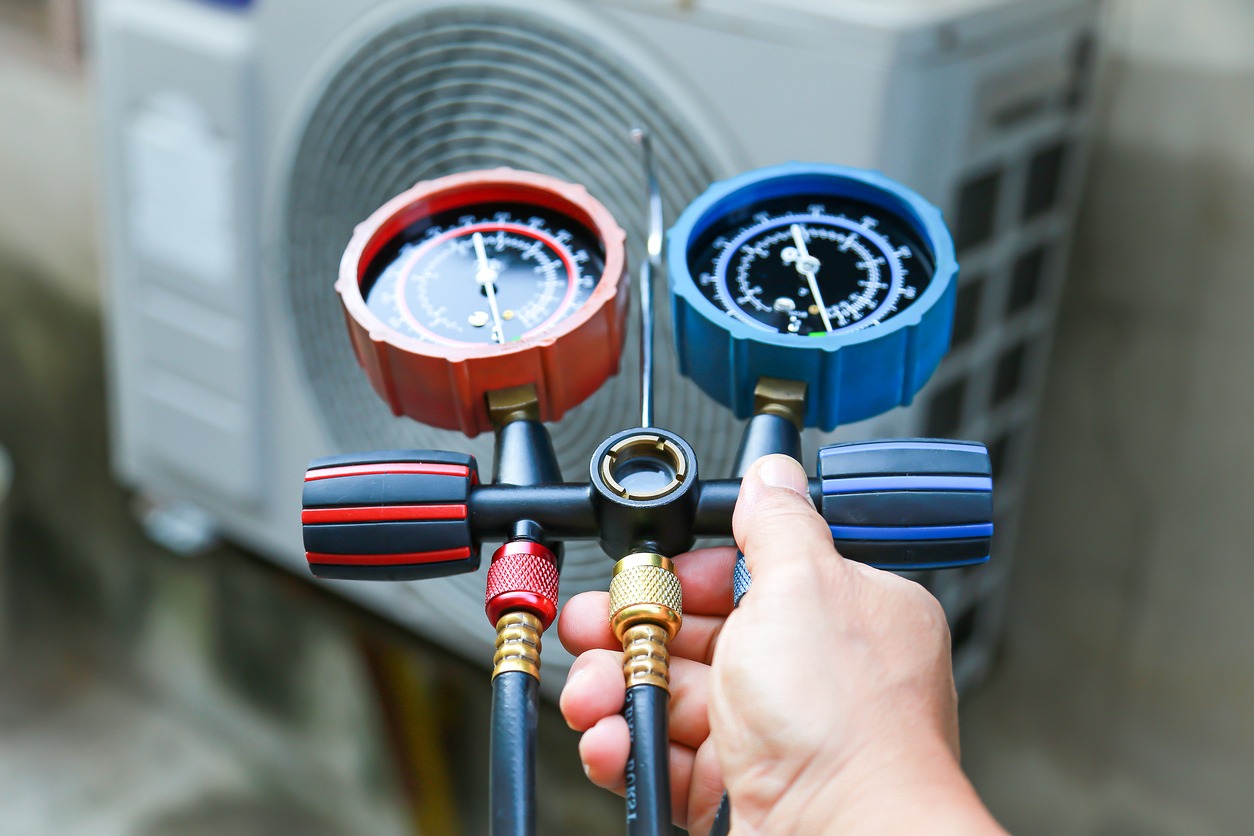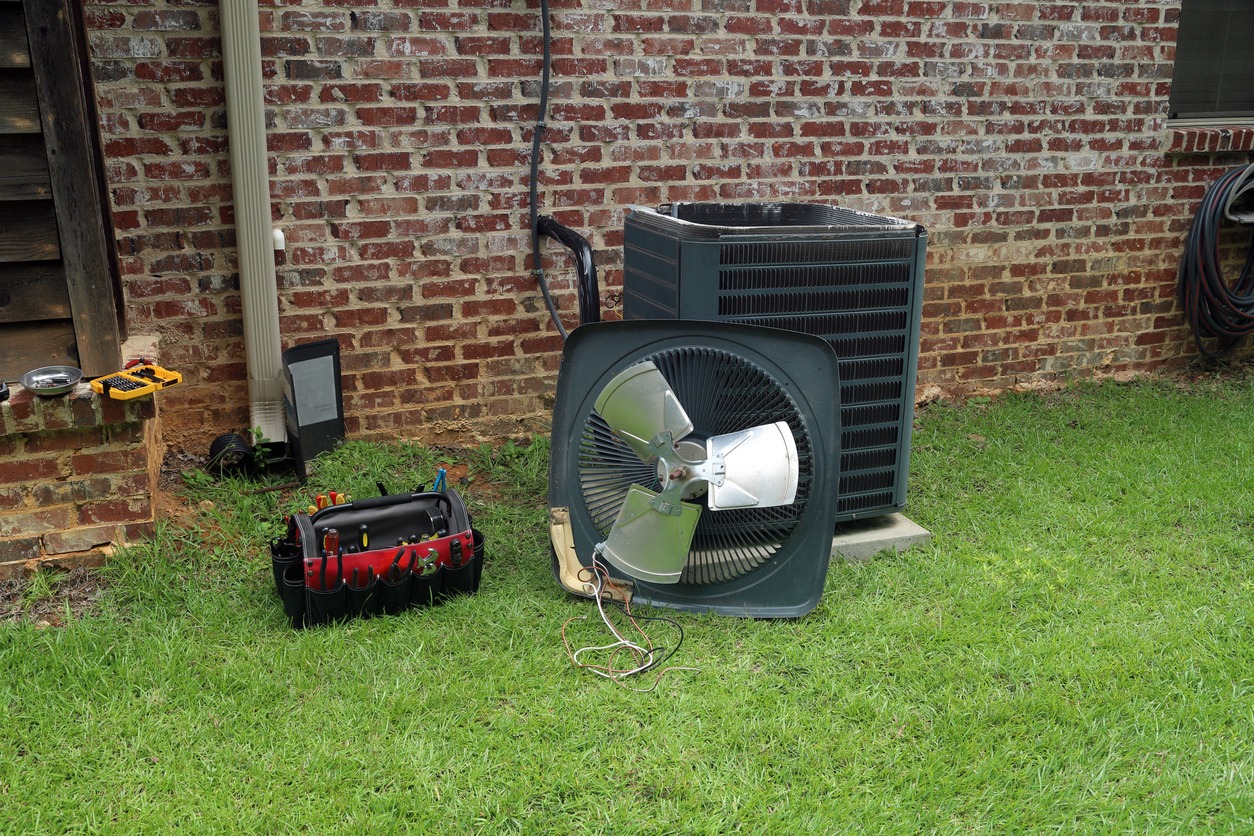Compressors are the heart of any air conditioning system, and a loud start-up noise can be a startling indicator that something is amiss. Homeowners and business operators alike often face the challenge of diagnosing and addressing the cacophony that can accompany an AC unit’s activation. This article delves into the common causes of these disruptive sounds and outlines practical solutions to mitigate them. Whether you’re contending with the wear and tear of an aging system, loose components, refrigerant issues, or electrical malfunctions, understanding the root of the problem is the first step towards a quieter and more efficient operation. With a focus on both DIY troubleshooting and knowing when to call in the professionals, we’ll guide you through the process of restoring peace and comfort to your environment.
Identifying the Causes of Loud Compressor Noises
When your home’s air conditioning unit emits a startling loud noise at start-up, it’s not just an annoyance—it could be a symptom of a deeper issue within the compressor. Pinpointing the root cause of these sounds is essential in taking the first step toward resolution.
Wear and Tear in Aging Compressors
The relentless cycle of compression and decompression in an air conditioner’s compressor takes a toll on its internal mechanisms over time. The piston, tirelessly working to compress refrigerant, can lead to increased clearance in the cylinder as piston rings and cylinder walls wear down. This deterioration often results in a struggle to build up the necessary pressure, which can manifest as jarring noises when the system kicks on.
Bearings within the compressor, designed to ensure the smooth rotation of the shaft, can also succumb to the ravages of time. As these bearings wear out, they may produce a distinct metallic grinding or screeching sound during the compressor’s activation.
Moreover, the internal motor of the compressor is not immune to wear. Its windings can weaken, leading to a laborious start. This might be heard as a loud hum or buzz as the compressor endeavors to start.
Acknowledging these signs of wear is crucial, as they can lead to decreased efficiency and potential system failure. It’s advisable to seek professional assessment at the first hint of such issues, to determine if repairs or a full replacement are in order.
Loose Components and Mountings
A common culprit behind the startling noises at compressor start-up is the gradual loosening of internal components or mountings. The persistent hum and vibration of everyday operation can cause bolts and fasteners to work themselves free. This can affect various parts, including the motor and condenser fan, leading to a symphony of rattles and clanks when the compressor kicks into gear.
Imagine the compressor as a heart, with each bolt and fastener acting as a vital artery. If these become loose, the heart cannot function without disturbance. In severe cases, the compressor itself may visibly quiver, a clear sign that the mounting bolts anchoring it to its base are no longer secure. This isn’t merely a nuisance; it’s a harbinger of potential damage to the system.
The design of mounting springs and rubber grommets is to absorb vibrations and minimize noise. Yet, these components are not immune to wear and can lose their effectiveness. When mountings become slack, they do more than just create noise; they compromise the system’s stability, leading to a tumultuous and potentially harmful start-up.
Addressing this issue can be as straightforward as tightening bolts or replacing worn bushings and grommets. However, precision is key. Over-tightening can be just as detrimental as neglect, potentially causing component damage. Adhering to the manufacturer’s torque specifications is essential to prevent further complications.
For these reasons, it’s often best to turn to a professional. They can ensure a correct diagnosis and take action to prevent damage from loose mountings and components. Early intervention is crucial to safeguard the air conditioning unit’s longevity and maintain its performance.
Inadequate Refrigerant Levels
Another significant factor contributing to loud compressor noises at start-up is insufficient refrigerant levels. The compressor, serving as the air conditioning system’s pump, depends on a specific amount of refrigerant to function effectively. When levels dip too low, the compressor strains to circulate the available refrigerant, often resulting in a jarring noise upon activation.
Leaks within the system or past servicing errors can lead to a gradual decline in refrigerant levels. These leaks may be elusive, requiring specialized detection equipment. As refrigerant diminishes, the compressor’s workload intensifies, leading to the disruptive sounds you hear.
The noise may manifest as bubbling or gurgling in the refrigerant lines, a telltale sign of air pockets forming due to inadequate pressure. This issue can also prompt the compressor to cycle on and off with greater frequency, accelerating wear and potentially shortening its lifespan.
Promptly addressing low refrigerant levels is not just a matter of performance—it’s also a legal requirement. Environmental regulations mandate the repair of leaks before adding refrigerant to a system.
Qualified technicians should handle the task of diagnosing and rectifying refrigerant issues. They have the expertise and equipment to measure the refrigerant charge accurately, locate and repair leaks, and refill the system according to the manufacturer’s guidelines. This not only alleviates the loud noises at start-up but also restores the air conditioning system to peak efficiency.
Electrical Malfunctions
The cacophony of a compressor’s loud start-up often has its roots in electrical malfunctions. These issues can disrupt the smooth operation of the compressor motor, manifesting as a jarring noise upon ignition. A notable culprit is the ‘hard start’ phenomenon, where the compressor labors to activate, hindered by electrical complications.
Consider the start capacitor, a critical component designed to deliver a voltage surge to jumpstart the compressor. Should this capacitor deteriorate, its diminished charge fails to provide the necessary power, leading to a protracted and noisy start-up.
Contactors, too, play a pivotal role in initiating the compressor’s motor. Over time, these may succumb to wear, with pitting and corrosion interrupting the electrical current. The result? A disconcerting chatter or buzz as the compressor stutters to life.
Moreover, the stability of electrical connections is paramount. Fluctuating power caused by loosened connections—often a byproduct of thermal cycling or operational vibrations—can also contribute to startling start-up sounds. Beyond noise concerns, such inconsistencies can accelerate compressor wear and pose potential safety hazards.
Given the intricacies and risks associated with electrical repairs, it’s imperative to enlist the expertise of a certified technician. They are equipped to safely test and rectify issues with capacitors, scrutinize contactors, and fortify electrical connections, ensuring your system resumes its quiet and efficient performance.
Troubleshooting and Diagnosing Compressor Noise
Pinpointing the source of your compressor’s clamor requires a systematic approach to troubleshooting. Homeowners can undertake an initial assessment to discern whether professional assistance is warranted.
Begin by attentively listening to the compressor’s sounds, noting if the noise is isolated to start-up or persists during operation. The character of the sound—be it buzzing, rattling, or hissing—provides valuable hints about the underlying issue.
A visual examination is equally telling. Look for conspicuous signs of damage or deterioration on the compressor and its environs. Confirm that the condenser unit is free from blockages that could impede airflow and overburden the compressor.
Tightening external components is another step to silence unnecessary vibrations. However, caution is advised to prevent causing further harm through excessive force.
Should these preliminary measures not uncover the issue, a deeper investigation is in order. This entails examining refrigerant levels with specialized tools, a task best left to professionals due to its complexity.
Electrical assessments should also be conducted with a multimeter to evaluate the health of capacitors and contactors. If these initial efforts don’t resolve the mystery, or if you suspect more complex problems like refrigerant or electrical faults, it’s prudent to consult a certified HVAC technician. Their advanced diagnostic equipment and specialized knowledge enable them to identify and address the root cause of compressor noise effectively, ensuring compliance with legal standards for certain repairs, particularly those involving refrigerant.
Conducting a Visual and Auditory Inspection
Embarking on a visual and auditory inspection is an essential preliminary step to pinpoint the source of your compressor’s loud start-up noises. This initial examination, which can typically be performed by the homeowner, involves a careful observation and listening exercise to identify possible malfunctions.
During the visual inspection, scrutinize the exterior condenser unit, the compressor’s abode. Search for any visible damage, such as distorted coil fins or signs of corrosion, which could be impairing its operation. Ensure there’s no debris or obstructions that might impede airflow, as a clean surrounding is crucial for optimal performance.
Moving indoors, inspect the air handler or furnace for any unusual signs, such as water leaks or excessive condensation, which could signal a problem with the refrigerant or drainage systems.
In terms of auditory inspection, the specific sounds your unit makes can be revealing. For instance, a persistent humming could point towards an electrical issue, whereas a clanking or banging noise at start-up often suggests internal components may have come loose. Should you detect a hissing or bubbling noise, this could be symptomatic of a refrigerant leak.
Excessive vibration or a rattling sound may indicate that screws, mounts, or panels have loosened, necessitating a closer look at the unit’s stability.
While these inspections can be conducted by homeowners, it’s imperative to understand that any subsequent work, especially when it involves electrical or refrigerant systems, should be entrusted to a certified professional. These initial observations can direct a technician to the underlying issue, but resolving it safely and effectively requires specialized tools and knowledge.
Checking Refrigerant and Electrical Systems
Delving into the refrigerant and electrical systems is a critical step in the diagnostic process for compressor noise. Due to the intricate nature of these systems and the potential risks involved, these evaluations are best left to the expertise of certified HVAC technicians.
A technician will approach the refrigerant system by attaching pressure gauges to the compressor’s service ports. This will reveal whether the system’s refrigerant charge is within the proper range. They will also deploy leak detection tools, such as a refrigerant leak detector or bubble solution, to uncover any elusive leaks that could be compromising system integrity.
Additionally, the technician will assess the expansion valve and filter drier for any obstructions or malfunctions that might be hindering refrigerant flow, which can exacerbate compressor noise.
For the electrical system, the technician will employ a multimeter to test the compressor motor’s windings for continuity and resistance, ensuring they are functioning correctly. Capacitors will be evaluated to confirm they are storing and releasing the necessary charge for compressor start-up. Wiring connections will be meticulously examined for tightness and wear to prevent erratic electrical supply, which can cause noise and damage. Lastly, the contactor’s condition will be assessed, checking for any signs of wear or failure that could affect system performance.
These detailed checks are not only vital for diagnosing the cause of compressor noise but also play a role in preempting further issues that could lead to system failure. Involving a professional at this juncture is not just about noise abatement; it’s about ensuring the system’s continued efficacy and durability.
Professional Solutions and When to Seek Help
Discerning when to call in the experts is crucial when dealing with the jarring sounds of a compressor kicking on. While initial inspections are within the wheelhouse of most homeowners, the intricate nature of compressors often necessitates a professional’s touch. Let’s explore the instances when expert assistance is not just beneficial but necessary.
A hissing noise or the presence of a leak during your preliminary checks points to a refrigerant issue. This is where HVAC technicians come in, as they are uniquely qualified and legally authorized to manage refrigerants. They will adeptly seal leaks, evacuate the system with precision, and replenish the refrigerant according to exact factory specifications, thus rectifying any pressure imbalances and silencing the disruptive noise.
Electrical issues, often indicated by a persistent hum or buzz, are another domain for professionals. They will meticulously assess the situation and, if needed, replace compromised capacitors, contactors, or wiring. Given the inherent risks of working with electricity, this task is best left to those with the requisite expertise to avoid injury and additional system damage.
As compressors age, they naturally degrade, and a raucous start-up could signal that your unit is nearing the end of its operational lifespan. In such cases, a technician may suggest a compressor replacement or other necessary updates to worn-out parts.
Should the commotion stem from loose components or mountings, a thorough service by a professional will not only address the immediate issue by tightening or replacing parts but also check for any collateral damage. They can determine if the problem extends to the mounting brackets or if isolation pads require substitution to avert future disturbances.
Professional help should be sought if:
- The noise continues despite your initial visual and auditory checks.
- Pinpointing the noise source proves elusive.
- Your inspection suggests refrigerant or electrical complications.
- The noise coincides with other malfunction indicators, such as inadequate cooling or frequent on-off cycling.
Trained HVAC technicians possess the tools, skills, and experience to safely and effectively resolve issues with AC compressor noise. DIY attempts at complex repairs can invalidate warranties, exacerbate problems, and pose safety risks. When your AC system’s functionality and safety are in question, it’s imperative to consult a professional.
Repair or Replacement of Compressor Components
Upon diagnosing the source of a compressor’s loud noise, a technician may conclude that certain parts within the compressor are in need of repair or outright replacement. This intricate process, often involving the disassembly of the AC unit’s components, should be entrusted to a seasoned professional due to the technical proficiency and safety considerations involved.
Components that frequently require attention include:
- Pistons and Connecting Rods: These parts can wear down in certain compressor models, leading to a knocking sound. Replacing them can quiet the compressor and prolong its service life.
- Compressor Motor: When bearings inside the compressor motor fail, they can produce a harsh grinding noise. In such cases, repairing or replacing the motor is essential.
- Mounting Springs: These springs buffer the compressor. If they malfunction, noise levels can increase, necessitating their replacement.
- Suction and Discharge Valves: These valves are critical for compressor operation, and when they fail, the noise can be significant. Due to the complexity of valve repair, this task is reserved for professionals.
After evaluating the compressor’s condition, the technician will advise whether it is more prudent to repair specific parts or to replace the entire compressor. Especially with older units, the cost of repairs might approach or even surpass the investment in a new compressor. In such scenarios, a full replacement might be recommended.
When a replacement is in order, professionals will ensure that the new compressor is compatible with your system’s specifications. They will also handle the installation and refrigerant charging, which are vital to the unit’s performance and in preventing future noise issues.
It’s important for homeowners to recognize that replacing a compressor may also necessitate a broader system evaluation. Issues like incorrect refrigerant levels or failing capacitors can impact the performance of a new compressor.
Decisions regarding repair or replacement should take into account the system’s age, warranty status, and overall condition. A professional will provide the necessary guidance to ensure a solution that is both sustainable and cost-effective.
Adjusting or Recharging Refrigerant
The lifeblood of any air conditioning system is its refrigerant, which necessitates careful monitoring and adjustment to ensure peak performance. Should a certified HVAC expert pinpoint the source of compressor racket to an imbalance in refrigerant levels, they’ll embark on a meticulous process to rectify the situation.
Detecting and sealing leaks forms the initial phase of this procedure. Technicians employ advanced tools like electronic leak detectors or introduce UV dye to the system, illuminating any breaches. Post-repair, the system is primed for the next steps.
Recharging the system is a multi-step endeavor:
- Evacuating the System: To begin, the technician purges the system, eradicating moisture and air that could degrade components and impede performance, leading to potential compressor disturbances.
- Precise Refrigerant Replenishment: The type and quantity of refrigerant are critical; the technician will infuse the exact amount recommended by the manufacturer to avoid cooling inefficiencies or compressor damage.
- Optimizing System Parameters: Following the recharge, the system’s pressure and temperature are scrutinized to confirm they meet the manufacturer’s guidelines. This includes evaluating superheat and subcooling levels to ensure the refrigerant charge is optimal.
- Operational Verification: To conclude, the technician will activate the air conditioning, monitoring for a reduction in noise and an increase in cooling efficiency.
Maintaining the correct refrigerant charge is not only crucial for minimizing noise but also for preserving the compressor’s lifespan. It’s worth noting that refrigerant handling is strictly regulated due to its environmental and health implications, underscoring the importance of professional involvement.
Servicing Electrical Components
Addressing the electrical underpinnings of a compressor is a pivotal step in mitigating start-up clamor. As components age or malfunction, they can disrupt normal operation, manifesting as unwelcome noise. Here’s how a professional might tackle these issues:
- Capacitor Service: A weakened capacitor struggles to store the necessary energy, leading to compressor strain. By measuring capacitance, technicians can identify and replace capacitors that fall short of their performance benchmarks.
- Contactor Evaluation: A compromised contactor, with its pitted or corroded contacts, can interrupt electrical flow, necessitating its replacement to restore seamless power to the compressor.
- Wiring Integrity Assessment: The technician will scrutinize all wiring for signs of wear, ensuring connections are secure to prevent arcing—a potential noise and hazard source. Any compromised wiring will be substituted with appropriate gauge wire.
- Compressor Windings Analysis: The resistance of compressor windings is indicative of their condition. An ohmmeter helps verify that these levels are within acceptable ranges, with rewinding or replacement as potential recommendations for any discrepancies.
- Overload Protector Check: This safety device, when tripped, signals excessive current draw, often due to electrical faults. Technicians will test and, if necessary, replace protectors to maintain system integrity.
Electrical servicing is conducted with the utmost adherence to safety standards, ensuring that all work is compliant with current codes. By entrusting this intricate work to seasoned professionals, you can alleviate noise issues and safeguard your HVAC system’s longevity and efficiency.
Maintaining Your AC to Prevent Loud Noises

A well-maintained air conditioning system not only operates quietly but also extends its lifespan and enhances its efficiency. Proactive maintenance can nip potential issues in the bud, averting the progression to more serious, noisy complications. Here’s how to keep your AC in top shape:
Scheduled Professional Maintenance: It’s wise to have your system checked by a certified HVAC professional at least once a year. They’ll thoroughly examine and service your AC, addressing any minor concerns before they escalate into noisy disruptions.
Securing and Dampening Vibrations: Tightening all fasteners can help eliminate sounds caused by vibrations. Additionally, technicians may recommend updating or adding anti-vibration pads to dampen any noise emanating from the unit.
Cleanliness and Lubrication of Moving Parts: Dust and debris can lead to premature wear, while proper lubrication of components like motors and bearings ensures silent and smooth operation, staving off any harsh sounds due to friction.
Regular Filter Replacement: Homeowners should replace or clean air filters regularly, typically every few months, to maintain optimal airflow and reduce the strain on the compressor that could lead to increased noise levels.
Clearance and Cleanliness Around the Outdoor Unit: Keep the area around your outdoor unit clear of debris to prevent blockages that can cause the system to overheat and become noisy. Regular cleaning of the condenser coils is also beneficial.
Monitoring Performance: Stay vigilant for any shifts in your AC’s performance, particularly unusual sounds, which could indicate the need for prompt attention.
Compliance with Manufacturer Recommendations: Adhering to the guidelines provided by your AC manufacturer helps ensure the unit operates as intended, minimizing the chance of noise-related issues.
By embracing these maintenance strategies, homeowners can play a pivotal role in preserving the serene operation of their AC systems, while also potentially avoiding expensive repairs in the future.
Scheduled Professional Maintenance
Enlisting the expertise of a qualified HVAC technician for regular maintenance is a cornerstone of AC care. These sessions are comprehensive and address several critical areas to prevent the emergence of loud compressor noises:
Inspection: The technician will conduct a detailed examination of your AC system, looking for any signs of wear or potential failures that could lead to noise or other malfunctions.
Cleaning: A thorough cleaning of the system, focusing on coils and blower components, is performed to ensure efficiency and quiet operation.
Lubrication: Proper lubrication is applied to moving parts to facilitate smooth functioning and to prevent any unsettling noises caused by metal-on-metal contact.
Tightening Electrical Connections: The technician will secure electrical connections to prevent any electrical noise or potential hazards.
Thermostat Calibration: Ensuring the thermostat is accurately reading and controlling the temperature is crucial for effective communication with the AC system.
Refrigerant Level Check: The technician will verify that refrigerant levels are optimal, addressing any leaks or recharging needs.
Ductwork Inspection: The ducts will be checked for any issues that could impact airflow and place undue stress on the compressor.
Air Filter Replacement: While homeowners can replace filters themselves, technicians can also perform this task, ensuring that air flows freely and without obstruction.
Review System Operation: Finally, the technician will operate the system to confirm that all components are functioning correctly, paying special attention to any unusual sounds.
Servicing intervals may vary based on factors such as the system’s age, usage intensity, and the surrounding environment. However, it’s generally recommended to service HVAC systems biannually, particularly before peak heating and cooling seasons. This proactive approach to maintenance is an investment in the quiet and efficient operation of your AC, offering reassurance that your system is well-maintained and less prone to unexpected issues.
Securing and Dampening Vibrations
A tranquil start-up and operation of your AC unit hinge on mitigating excessive vibrations, which can amplify compressor noise. To ensure stability and quietude, a technician will undertake the following:
- Bolts and Screws Tightening: A meticulous examination and tightening of all fasteners on the compressor and its support structures are essential. This step is crucial as even minor looseness can lead to significant noise.
- Mounting Brackets Assessment: The compressor’s mounting brackets will be scrutinized for any signs of wear or damage. Compromised brackets will be promptly replaced to maintain the compressor’s secure positioning.
- Isolation Pads Evaluation: The condition of the rubber or foam pads under the compressor, which serve to absorb vibrations, will be assessed. Degraded or stiffened pads will be substituted to restore their noise-dampening efficacy.
To further diminish vibrations, several additional strategies can be employed:
- Vibration Isolators Installation: These devices are engineered to separate the compressor from the AC unit’s structure, thereby curtailing the transmission of vibrations and the resultant noise.
- Sound Blankets Utilization: Encasing compressors in sound blankets can significantly muffle operational sounds, an especially valuable solution in residential settings where peace is paramount.
- Anti-Vibration Compounds Application: Select compounds can be applied to specific system parts to dampen vibrations. These are used judiciously, in line with manufacturer recommendations, to avoid any negative impact on system performance.
While some degree of vibration is to be expected, it’s imperative to address any excessive movement that contributes to noise promptly. This not only augments the serenity of your living space but also safeguards the AC system from potential damage, ensuring its longevity and performance.
Cleanliness and Lubrication of Moving Parts
A well-maintained AC system operates quietly and efficiently, with cleanliness and lubrication playing pivotal roles. Here’s how these practices contribute to a serene and effective unit:
- Coils and Fans Cleaning: Dirt and debris tend to accumulate on coils and fan blades, leading to imbalance and noise. A thorough cleaning by professionals will alleviate these issues, ensuring balance and quiet operation.
- Motors and Bearings Lubrication: To avoid the cacophony of grinding or squealing, motors and bearings require regular lubrication. Technicians will apply the appropriate lubricants to maintain smooth operation and prevent noise due to friction.
- Rust and Corrosion Inspection: Technicians will also inspect for rust and corrosion, which can lead to premature wear or seizing of parts. Preventative measures, including the application of protective coatings, may be recommended.
- Blower Assembly Maintenance: The blower assembly is critical for quiet operation. It will be cleaned and inspected for damage that could lead to disruptive noise during compressor start-up or while running.
Adhering to the manufacturer’s guidelines for maintenance intervals is crucial, especially in environments that may accelerate wear, such as dusty conditions or high usage areas. It is advised against attempting to lubricate internal components without proper training, as this can lead to over-lubrication or damage from incorrect products.
Incorporating these practices into a regular maintenance routine not only prevents noise disturbances but also enhances the overall efficiency and longevity of your air conditioning system.
Useful FAQs for Troubleshooting Compressor Loud Start-Up Noises
1. What are the different types of noises a compressor can make on start-up?
On start-up, a compressor can produce several sounds such as knocking, hissing, clanking, or loud humming. These noises can vary depending on the unit and the nature of the problem causing them.
2. What is the primary cause of loud noises when a compressor starts up?
The usual causes of loud start-up noises in compressors include loose parts, compressor cavitation, a faulty motor or bearings, low oil level, or a failing capacitor. These issues can lead to sudden, loud noise during startup.
3. How can a failing capacitor cause loud noises from a compressor?
A failing capacitor, which helps start and run the compressor, can struggle to provide enough power, resulting in a loud, abnormal noise. This sound typically suggests a requirement for the immediate replacement of the capacitor.
4. How does compressor cavitation contribute to loud noises?
Compressor cavitation happens when liquid refrigerant in the compressor boils off, causing vapor bubbles. When these bubbles collapse subjected to high pressure, they create loud and concerning noises.
5. Can preventive maintenance reduce the chance of loud start-up noises in compressors?
Absolutely. Regular preventive maintenance helps to detect and fix potential issues before a significant failure occurs. By doing so, the risk of the compressor producing loud start-up noises is noticeably reduced.
6. What should be done when a compressor starts making loud noises?
When a compressor starts making loud noises, one should consider contacting a professional technician immediately. The expert will diagnose the problem accurately and propose the appropriate solutions to rectify the issue.



